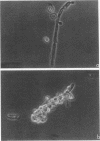Abstract
Pseudohyphal but not yeast forms of Candida albicans possess both iC3b and C3d receptors, as determined by rosetting with erythrocytes carrying iC3b (EAC3bi) or C3d (EAC3d). Rosetting with EAC3d was markedly reduced when pseudohyphae were heat killed or treated with trypsin or pronase but was not inhibited by several saccharides or aminosaccharides, including alpha-methyl-D-mannoside, or by pretreatment of pseudohyphae with concanavalin A. However, mannoproteins obtained by concanavalin A affinity chromatography of whole pseudohyphal extracts inhibited the attachment of EAC3d to C. albicans, whereas soluble (nonmannosylated) proteins were less active. Thus, although the C3d receptors appeared to be glycosylated, the oligosaccharide component of the receptor was apparently not involved in the recognition of C3d. To isolate these receptors, whole-cell extracts were separated by DEAE-Trisacryl chromatography. Fractions that inhibited rosetting were pooled and affinity purified by C3d-Thiol-Sepharose chromatography. The eluate from this affinity column inhibited attachment of C. albicans to EAC3d. Monoclonal antibodies to C. albicans were prepared, and three of these antibodies blocked rosetting. Western blotting (immunoblotting) with these antibodies indicated the presence of 62- and 70-kilodalton receptors for C3d in the extracts purified by C3d affinity chromatography and separated by sodium dodecyl sulfate-polyacrylamide gel electrophoresis.
Full text
PDF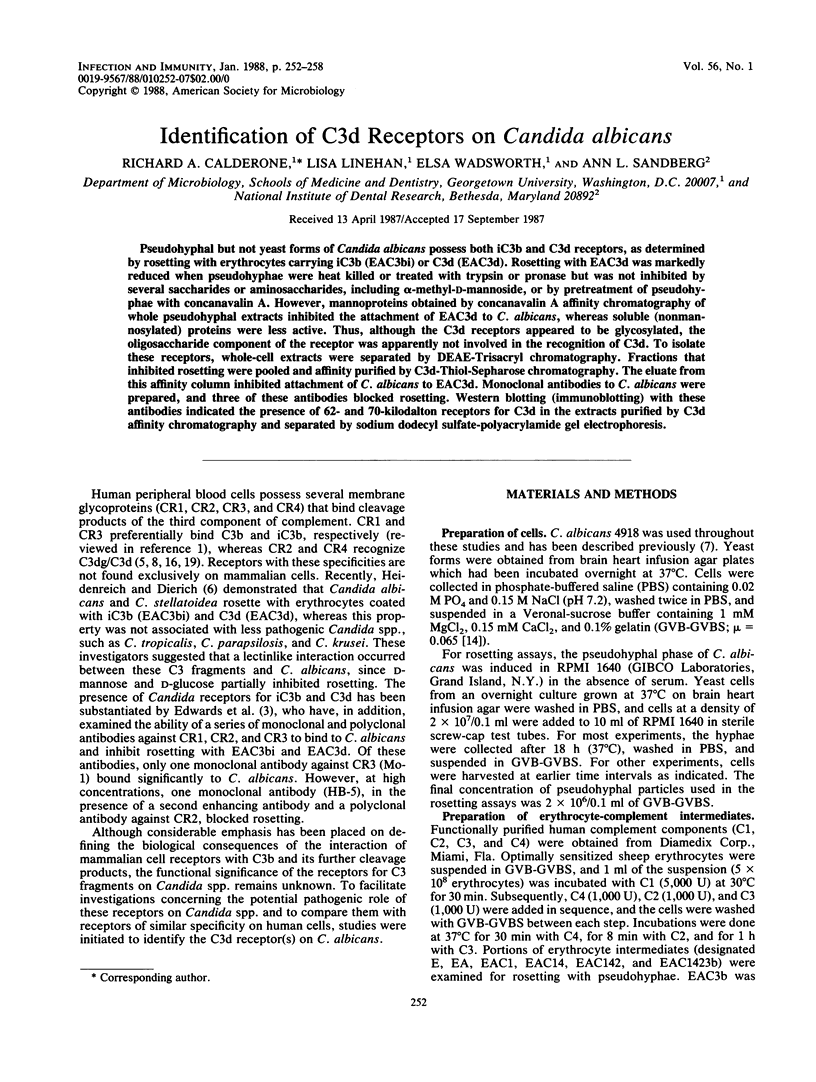
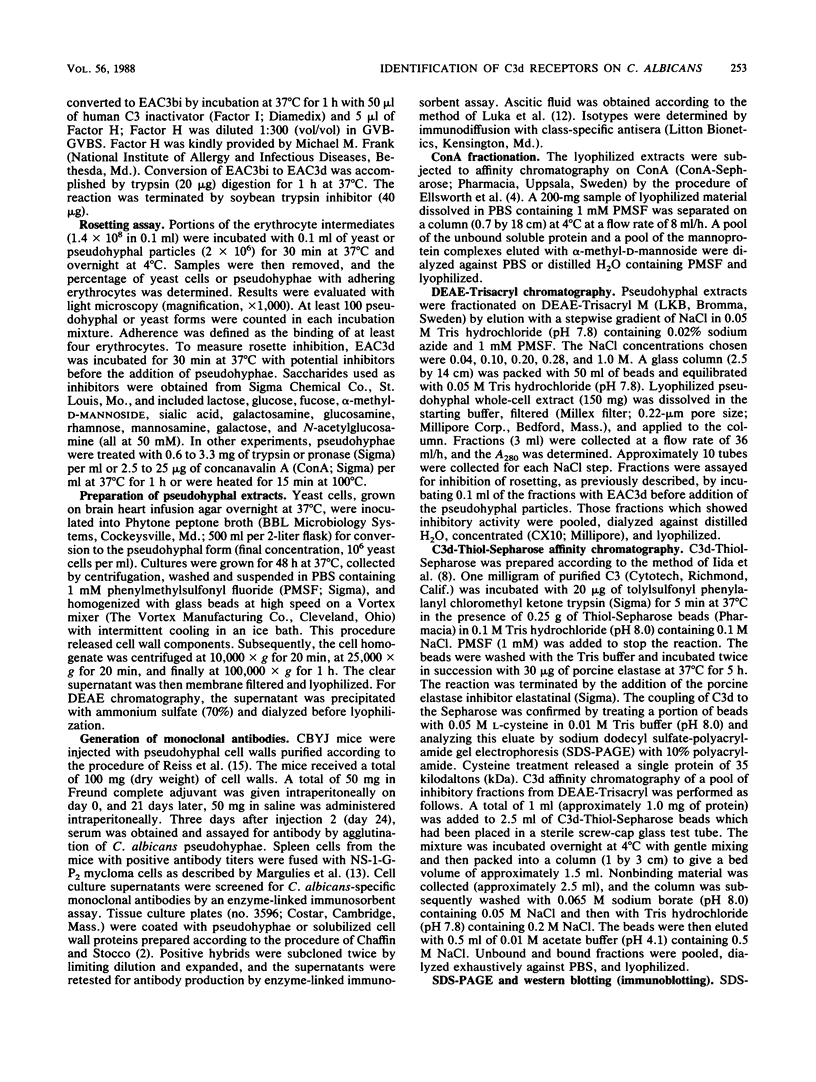
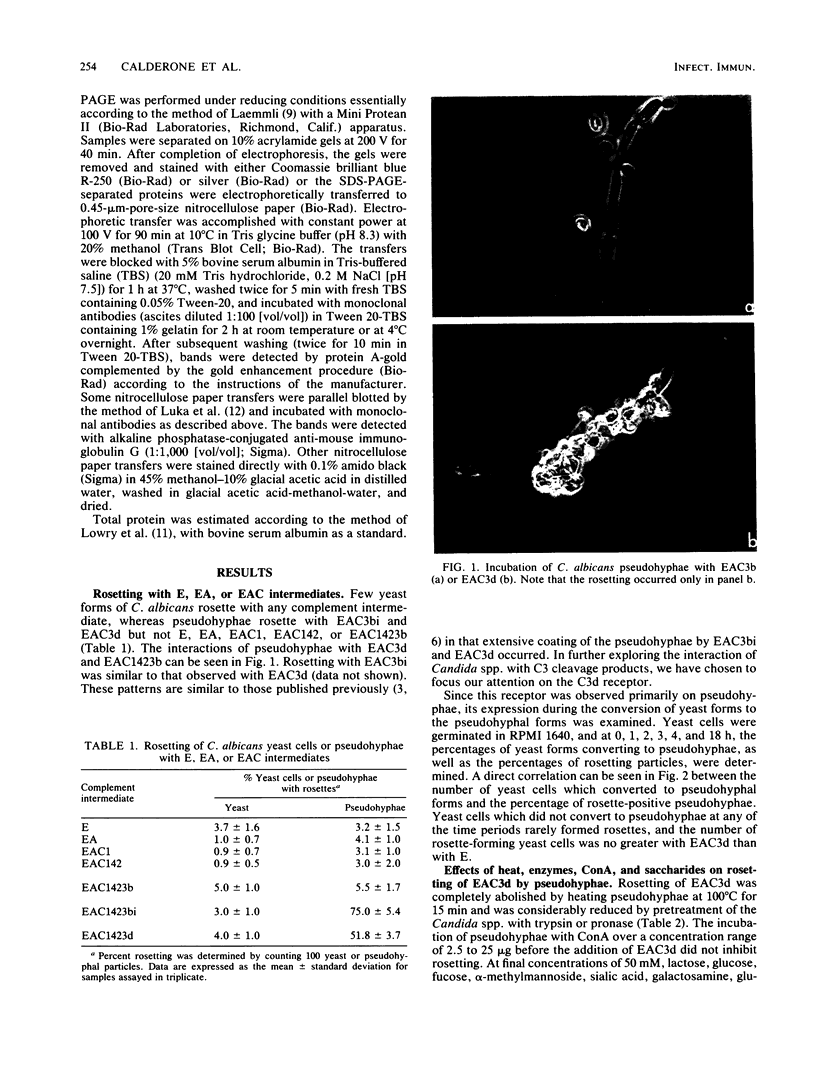
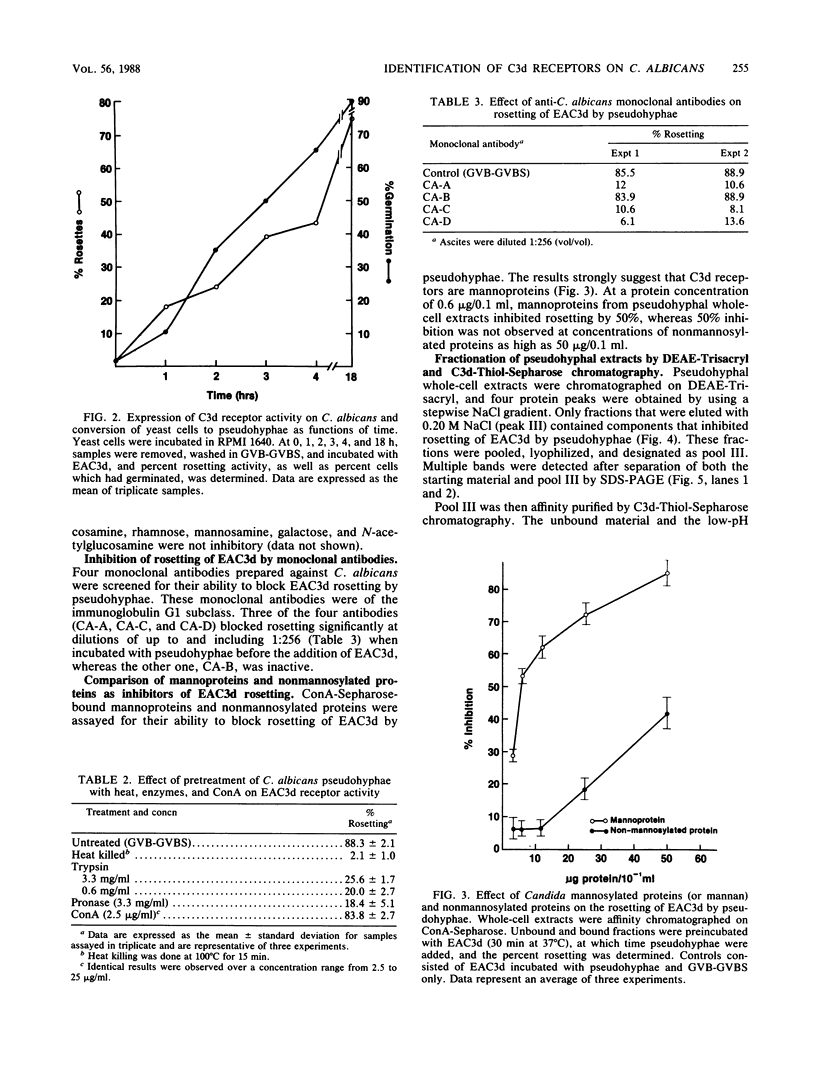
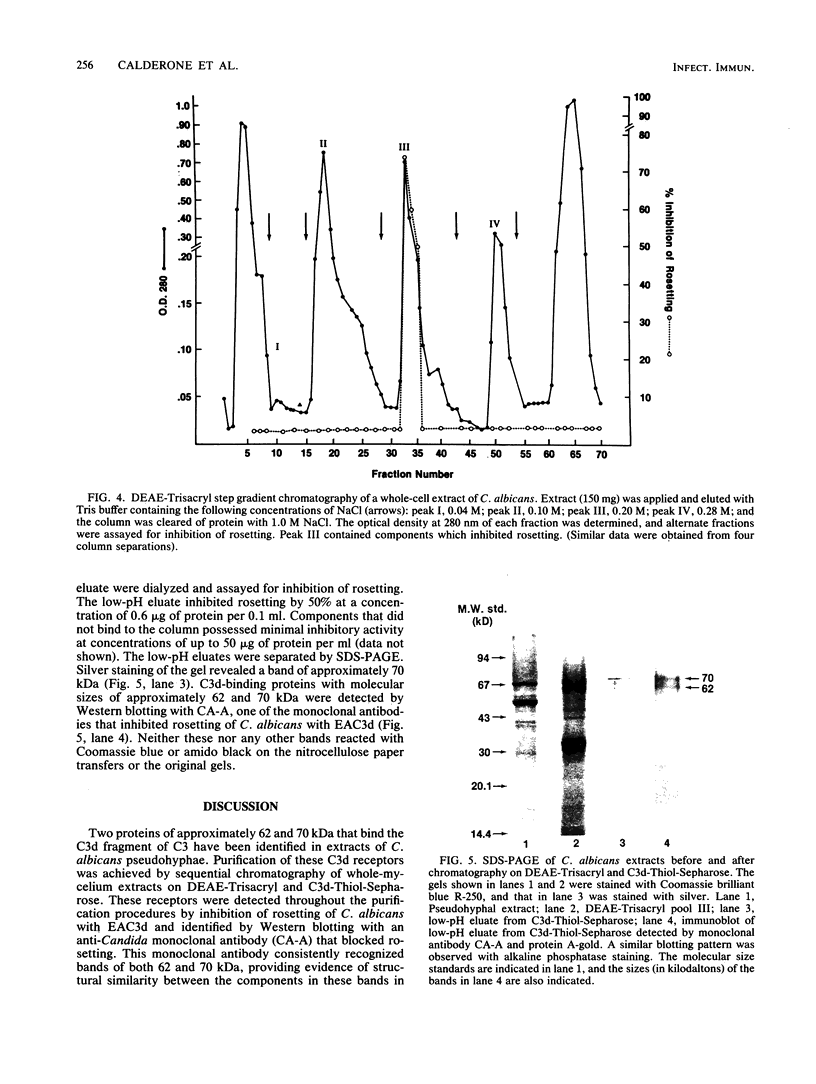
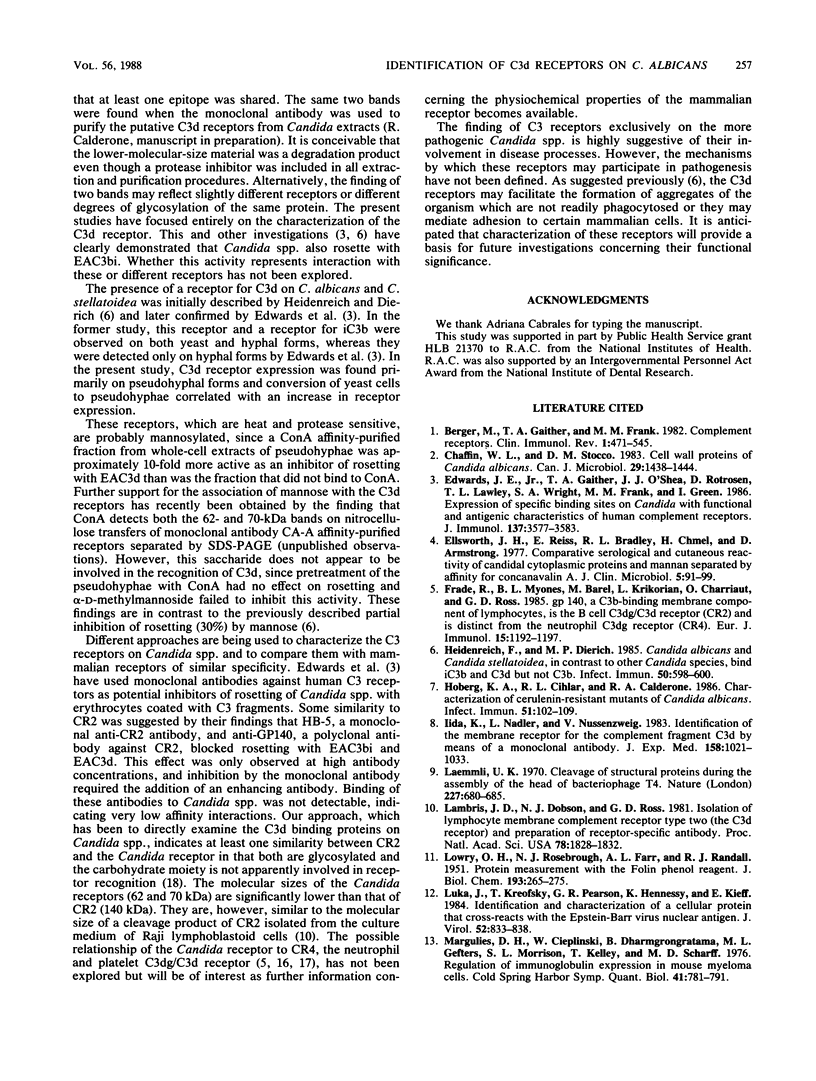
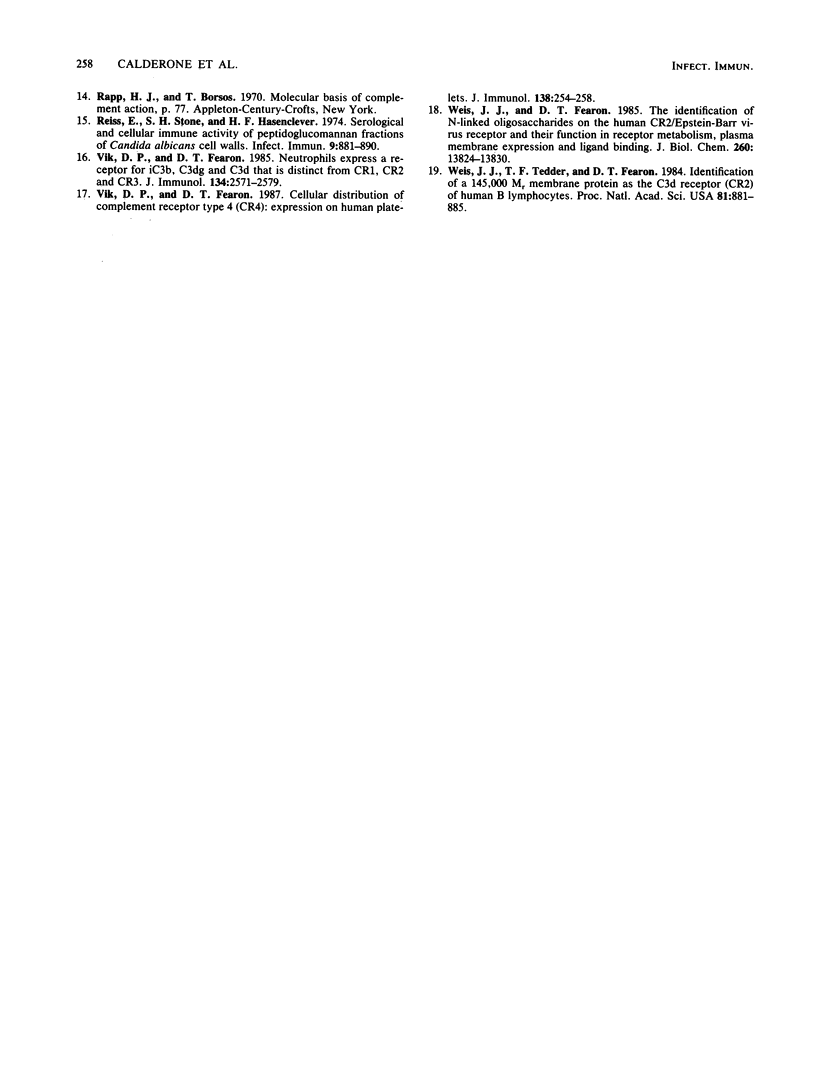
Images in this article
Selected References
These references are in PubMed. This may not be the complete list of references from this article.
- Berger M., Gaither I. A., Frank M. M. Complement receptors. Clin Immunol Rev. 1981;1(4):471–545. [PubMed] [Google Scholar]
- Chaffin W. L., Stocco D. M. Cell wall proteins of Candida albicans. Can J Microbiol. 1983 Oct;29(10):1438–1444. doi: 10.1139/m83-220. [DOI] [PubMed] [Google Scholar]
- Edwards J. E., Jr, Gaither T. A., O'Shea J. J., Rotrosen D., Lawley T. J., Wright S. A., Frank M. M., Green I. Expression of specific binding sites on Candida with functional and antigenic characteristics of human complement receptors. J Immunol. 1986 Dec 1;137(11):3577–3583. [PubMed] [Google Scholar]
- Ellsworth J. H., Reiss E., Bradley R. L., Chmel H., Armstrong D. Comparative serological and cutaneous reactivity of candidal cytoplasmic proteins and mannan separated by affinity for concanavalin A. J Clin Microbiol. 1977 Jan;5(1):91–99. doi: 10.1128/jcm.5.1.91-99.1977. [DOI] [PMC free article] [PubMed] [Google Scholar]
- Frade R., Myones B. L., Barel M., Krikorian L., Charriaut C., Ross G. D. gp140, a C3b-binding membrane component of lymphocytes, is the B cell C3dg/C3d receptor (CR2) and is distinct from the neutrophil C3dg receptor (CR4). Eur J Immunol. 1985 Dec;15(12):1192–1197. doi: 10.1002/eji.1830151210. [DOI] [PubMed] [Google Scholar]
- Heidenreich F., Dierich M. P. Candida albicans and Candida stellatoidea, in contrast to other Candida species, bind iC3b and C3d but not C3b. Infect Immun. 1985 Nov;50(2):598–600. doi: 10.1128/iai.50.2.598-600.1985. [DOI] [PMC free article] [PubMed] [Google Scholar]
- Hoberg K. A., Cihlar R. L., Calderone R. A. Characterization of cerulenin-resistant mutants of Candida albicans. Infect Immun. 1986 Jan;51(1):102–109. doi: 10.1128/iai.51.1.102-109.1986. [DOI] [PMC free article] [PubMed] [Google Scholar]
- Iida K., Nadler L., Nussenzweig V. Identification of the membrane receptor for the complement fragment C3d by means of a monoclonal antibody. J Exp Med. 1983 Oct 1;158(4):1021–1033. doi: 10.1084/jem.158.4.1021. [DOI] [PMC free article] [PubMed] [Google Scholar]
- LOWRY O. H., ROSEBROUGH N. J., FARR A. L., RANDALL R. J. Protein measurement with the Folin phenol reagent. J Biol Chem. 1951 Nov;193(1):265–275. [PubMed] [Google Scholar]
- Laemmli U. K. Cleavage of structural proteins during the assembly of the head of bacteriophage T4. Nature. 1970 Aug 15;227(5259):680–685. doi: 10.1038/227680a0. [DOI] [PubMed] [Google Scholar]
- Lambris J. D., Dobson N. J., Ross G. D. Isolation of lymphocyte membrane complement receptor type two (the C3d receptor) and preparation of receptor-specific antibody. Proc Natl Acad Sci U S A. 1981 Mar;78(3):1828–1832. doi: 10.1073/pnas.78.3.1828. [DOI] [PMC free article] [PubMed] [Google Scholar]
- Luka J., Kreofsky T., Pearson G. R., Hennessy K., Kieff E. Identification and characterization of a cellular protein that cross-reacts with the Epstein-Barr virus nuclear antigen. J Virol. 1984 Dec;52(3):833–838. doi: 10.1128/jvi.52.3.833-838.1984. [DOI] [PMC free article] [PubMed] [Google Scholar]
- Margulies D. H., Cieplinski W., Dharmgrongartama B., Gefter M. L., Morrison S. L., Kelly T., Scharff M. D. Regulation of immunoglobulin expression in mouse myeloma cells. Cold Spring Harb Symp Quant Biol. 1977;41(Pt 2):781–791. doi: 10.1101/sqb.1977.041.01.089. [DOI] [PubMed] [Google Scholar]
- Reiss E., Stone S. H., Hasenclever H. F. Serological and cellular immune activity of peptidoglucomannan fractions of Candida albicans cell walls. Infect Immun. 1974 May;9(5):881–890. doi: 10.1128/iai.9.5.881-890.1974. [DOI] [PMC free article] [PubMed] [Google Scholar]
- Vik D. P., Fearon D. T. Cellular distribution of complement receptor type 4 (CR4): expression on human platelets. J Immunol. 1987 Jan 1;138(1):254–258. [PubMed] [Google Scholar]
- Vik D. P., Fearon D. T. Neutrophils express a receptor for iC3b, C3dg, and C3d that is distinct from CR1, CR2, and CR3. J Immunol. 1985 Apr;134(4):2571–2579. [PubMed] [Google Scholar]
- Weis J. J., Fearon D. T. The identification of N-linked oligosaccharides on the human CR2/Epstein-Barr virus receptor and their function in receptor metabolism, plasma membrane expression, and ligand binding. J Biol Chem. 1985 Nov 5;260(25):13824–13830. [PubMed] [Google Scholar]
- Weis J. J., Tedder T. F., Fearon D. T. Identification of a 145,000 Mr membrane protein as the C3d receptor (CR2) of human B lymphocytes. Proc Natl Acad Sci U S A. 1984 Feb;81(3):881–885. doi: 10.1073/pnas.81.3.881. [DOI] [PMC free article] [PubMed] [Google Scholar]



